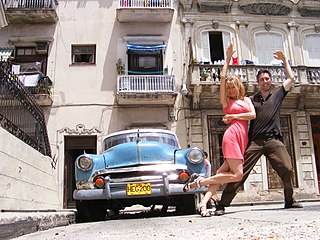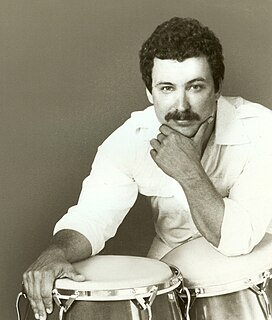Related Research Articles

Salsa music is a popular style of Latin American music. Because most of the basic musical components predate the labeling of salsa, there have been many controversies regarding its origin. Most songs considered as salsa are primarily based on son montuno, with elements of mambo, Latin jazz, bomba, plena and guaracha. All of these elements are adapted to fit the basic son montuno template when performed within the context of salsa.
Charanga is a traditional ensemble that plays Cuban dance music. They made Cuban dance music popular in the 1940s and their music consisted of heavily son-influenced material, performed on European instruments such as violin and flute by a Charanga orchestra.. The style of music that is most associated with a Charanga is termed 'Danzón', and is an amalgam of both European classical music and African rhythms.

Los Van Van is one of the leading musical groups of post-revolutionary Cuba. It was founded in 1969 by bassist Juan Formell, who directed the band until his death in 2014. Formell and former band members Changuito and Pupy are some of the most important figures in contemporary Cuban music, having contributed to the development of songo and timba, two popular dance music genres.

Orquesta típica, or simply a típica, is a Latin American term for a band which plays popular music. The details vary from country to country. The term tends to be used for groups of medium size in some well-defined instrumental set-up.

Timba is a Cuban genre of music based on Cuban son with salsa, American funk/R&B and the strong influence of Afro-Cuban folkloric music. Timba rhythm sections differ from their salsa counterparts, because timba emphasizes the bass drum, which is not used in salsa bands. Timba and salsa use the same tempo range and they both use the standard conga marcha. Almost all timba bands have a trap drummer. Timbas also often break the basic tenets of arranging the music in-clave. Timba is considered to be a highly aggressive type of music, with rhythm and "swing" taking precedence over melody and lyricism. Associated with timba is a radically sexual and provocative dance style known as despelote. It is a dynamic evolution of salsa, full of improvisation and Afro Cuban heritage, based on son, Rumba and mambo, taking inspiration from Latin jazz, and is highly percussive with complex sections. Timba is more flexible and innovative than salsa, and includes a more diverse range of styles. Timba incorporates heavy percussion and rhythms which originally came from the barrios of Cuba.
Carlos Manuel "Charlie" Palmieri was an American bandleader and musical director of salsa music. He was known as the "Giant of the Keyboards".

Eddie Palmieri is an American Grammy Award-winning pianist, bandleader, musician, and composer of Puerto Rican ancestry. He is the founder of the bands La Perfecta, La Perfecta II, and Harlem River Drive.
Joe Cuba, was an American conga drummer of Puerto Rican descent widely regarded as the "Father of Latin Boogaloo".

Pablo Rodríguez Lozada, better known as Tito Rodríguez, was a Puerto Rican singer and bandleader. He started his career singing under the tutelage of his brother, Johnny Rodríguez. In the 1940s, both moved to New York, where Tito worked as a percussionist in several popular rhumba ensembles, before directing his own group to great success during the 1950s. His most prolific years coincided with the peak of the mambo and cha-cha-cha dance craze. He also recorded boleros, sones, guarachas and pachangas.
Songo is a genre of popular Cuban music, created by the group Los Van Van in the early 1970s. Songo incorporated rhythmic elements from folkloric rumba into popular dance music, and was a significant departure from the son montuno/mambo-based structure which had dominated popular music in Cuba since the 1940s. Blas Egües was the first drummer in Los Van Van, but it was the band's second drummer, José Luis Quintana "Changuito", who developed songo into the world-wide phenomenon it is today.
Pachanga is a genre of music which is described as a mixture of son montuno and merengue and has an accompanying signature style of dance. This type of music has a festive, lively style and is marked by jocular, mischievous lyrics. Pachanga originated in Cuba in the 1950s and played an important role in the evolution of Caribbean style music as it is today. Considered a prominent contributor to the eventual rise of salsa, Pachanga itself is an offshoot of Charanga style music. Very similar in sound to Cha-Cha but with a notably stronger down-beat, Pachanga once experienced massive popularity all across the Caribbean and was brought to the United States by Cuban immigrants post World War II. This led to an explosion of Pachanga music in Cuban music clubs that influenced Latin culture in the United States for decades to come.

Prudencio Mario Bauzá Cárdenas was an Afro-Cuban jazz, Latin, and jazz musician. He was among the first to introduce Cuban music to the United States by bringing Cuban musical styles to the New York City jazz scene. While Cuban bands had had popular jazz tunes in their repertoire for years, Bauzá's composition "Tangá" was the first piece to blend jazz harmony and arranging technique, with jazz soloists and Afro-Cuban rhythms. It is considered the first true Afro-Cuban jazz or Latin jazz tune.
Tony Vega Cesar, known professionally as Tony Vega is a Puerto Rican salsa singer.
Típica 73 was an American charanga and salsa band in the 1970s and early 1980s, that was formed by musicians from Ray Barretto's band. "Típica" refers to the typical configuration of a Cuban chararanga while "73" refers to the year that group was founded. Tipica 73 was the first American salsa band to record in Cuba and included Adalberto Santiago, Alfredo de la Fé, and José Alberto "El Canario".

Juan Pablo Pacheco Knipping, known as Johnny Pacheco, was a Dominican-American musician, arranger, composer, bandleader, and record producer Who in the 1970s became one of the leading exponents of Salsa as well in the late 1950s called the pachanga, a blend of Cuban rhythms and Dominican merengue, which propelled him to worldwide fame and had an important role in the evolution of Latin music.
Alfredo Manuel De La Fé is a Cuban-born and New York-based violinist who lived in Colombia for more than 16 years and is responsible for transforming the violin into an important sound of Salsa and Latin music. The first solo violinist to perform with a Salsa orchestra, De La Fé has toured the world more than thirty times, appearing in concert and participating in more than one hundred albums by such top-ranked Latin artists as Eddie Palmieri, Tito Puente, Celia Cruz, José Alberto "El Canario", Cheo Feliciano, The Fania All-Stars, Santana and Larry Harlow. His second solo album, Alfredo, released in 1979, received a Grammy nomination as "Best Latin album".
Richard Egües, nicknamed "la flauta mágica", was a Cuban flautist and musician, one of the country's most famous artists. Egües was a member of the Orquesta Aragón band which he joined in 1955. He was also a strong supporter of the Cuban Revolution. A few days before he died, Richard Egües stated "I would give my life for him", referring to the Cuban President Fidel Castro, who was very sick at the time.
Cha-cha-chá is a genre of Cuban music. It has been a popular dance music which developed from the Danzón-mambo in the early 1950s, and became widely popular throughout the entire world.

Roger Dawson is a jazz percussionist, conga drummer, bandleader and jazz composer. He was a leading jazz and salsa disc jockey in the US and acknowledged as at the forefront of New York's salsa music explosion of the seventies and early eighties. He was the creator of the long running "Salsa Meets Jazz" concert series at New York's Village Gate club.

"Suavecito" is a Cuban son written by Ignacio Piñeiro and first recorded by his Septeto Nacional in 1929. It is a standard of the son repertoire and one of the biggest hits by the Septeto Nacional. It has been covered by numerous artists including Cuarteto Machín, Celia Cruz, Orquesta Aragón and Sierra Maestra.
References
- 1 2 Colin Larkin, ed. (1992). The Guinness Encyclopedia of Popular Music (First ed.). Guinness Publishing. pp. 329/330. ISBN 0-85112-939-0.
- ↑ Cesar Miguel Rondón, The Book of Salsa: A Chronicle of Urban Music from the Caribbean, 2008, p. 186 : "The actual protagonist of this new spin-off was none other than the Orquesta Broadway, rightfully considered the dean of the ... Orquesta Broadway was formed by the three Zervigón brothers and was the only charanga ensemble able to ..."